This post may contain affiliate links. Please read our disclosure policy.
Vegetarian Bibimbap Recipe with loads of vegetables and homemade Korean-inspired bibimbap sauce that tastes savory, sweet, tangy, and little spicy! Don’t forget to add the super crispy fried egg to your bibimbap rice bowl and mix it all up into one big bowl of deliciousness! 😀
For a sister version, check out my Crispy rice bibimbap salad!
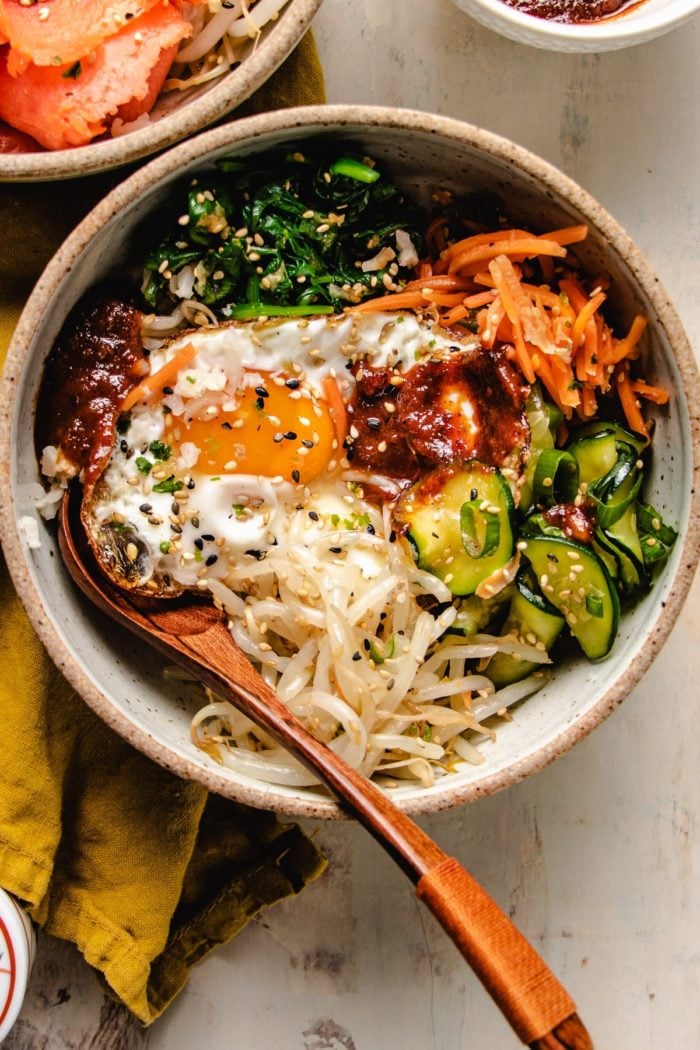
Table of Contents
- Bibimbap Recipe with homemade gochujang sauce (vegetarian, paleo, whole30)
- What is bibimbap
- Ingredients for bibimbap vegetarian or vegan
- Bibimbap Sauce (Korean chili pepper paste made Paleo, Whole30, GF)
- How to make Vegetarian Korean bibimbap recipe
- Endless Bibimbap Toppings and Swap Suggestions
- Vegetarian Bibimbap Recipe with bibimbap sauce
Bibimbap Recipe with homemade gochujang sauce (vegetarian, paleo, whole30)
Bibimbap is one of my must-have dishes whenever I crave Korean food! It’s filled with loads of fresh vegetables and an intensely flavored Bibimbap sauce. What I love about this dish is that you can pick-and-choose any vegetables and proteins and you can make all of the components in advance! The vegetables taste EVEN BETTER when chilled. Perfect for hot summer!
Today’s vegetarian bibimbap recipe and the bibimbap sauce are inspired by two Korean restaurants that Nate and I visit frequently – Ms Ohho in Brooklyn (p.s. We love their bibimbap sauce…SO GOOD) and Gahwa in Flushing, Queens.
What is bibimbap
Bibimbap is a Korean rice bowl dish topped with all kinds of seasoned vegetables, marinated meat (usually beef), a fried egg, and a deeply savory-sweet-spicy bibimbap sauce that’s also known as Korean chili pepper paste. Bibimbap [BEE-bim-bap] translates to mixed rice.
I learned from this article that in Korean cooking there are various kinds of bibimbap and it turns out my favorite types fall under jeonju bibimbap (the most popular version we see in the West and the one we’re making it today) and dolsot bibimbap (cooked in hot stone pot) categories.
No matter which vegetables or toppings you choose, definitely serve your bibimbap with a big spoonful of bibimbap sauce! Mix it all up with a spoon and dig-in!
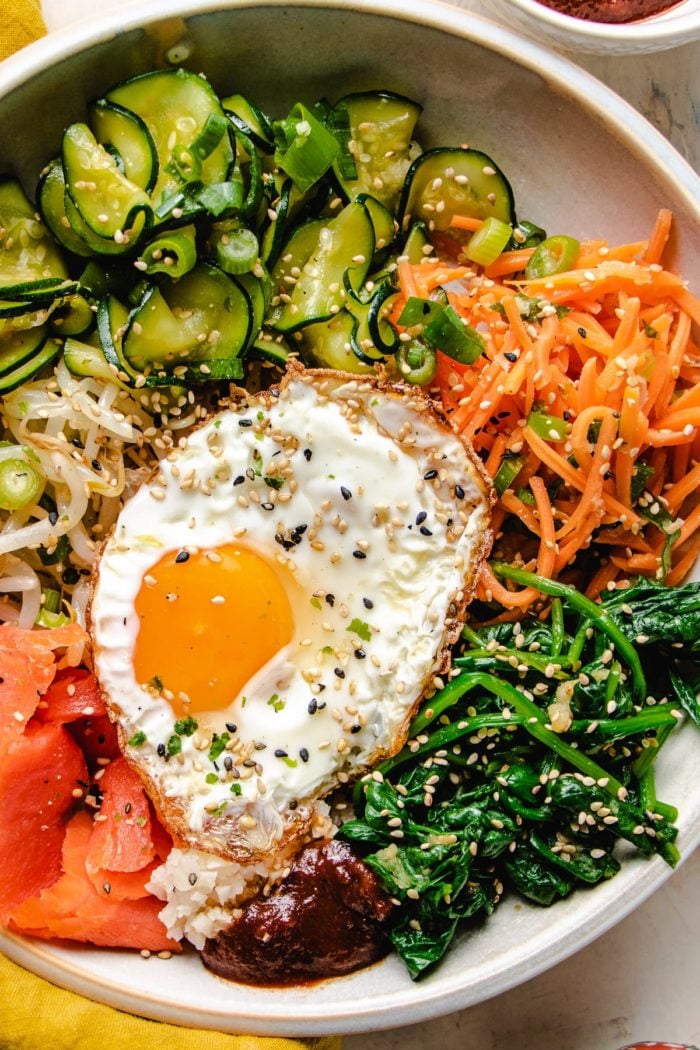
Ingredients for bibimbap vegetarian or vegan
The fun part of making your own Korean rice bowl is that you can pick-and-choose your vegetable combinations. I recommend selecting no fewer than 2 or 3 veggies and in different colors so that your homemade bibimbap bowl looks gorgeous and colorful! The ingredients are cooked separately but they share the same cooking steps and seasonings so it’s super straightforward. Tip: each component is a great side dish itself so it’s perfect for meal prep and make-ahead summer side dishes!
Here are the ingredients in my bibimbap bowl:
- Bibimbap Vegetables
- Mung bean sprouts
- Spinach
- Carrots
- Zucchini
- Eggs
- Rice
- Steamed white rice or cauliflower rice (for low carb folks)
- Bibimbap sauce
- Garnish
- Scallions
- Toasted white sesame seeds
- Seasonings:
- Toasted sesame oil
- Fine sea salt
- Grated or finely minced garlic
- Coconut aminos or gluten-free soy sauce
Because my blog is a paleo blog, all of the ingredients and seasonings I use in this recipe are also gluten-free, soy-free, and low carb friendly.

Bibimbap Sauce (Korean chili pepper paste made Paleo, Whole30, GF)
Gochujang is the essential component to make bibimbap sauce. The paste is SO GOOD that I made a Paleo gochujang for my audience! Although it’s a faux version, it’s super easy to make …just blend…and guess what? People love it! 😀 You can use the paste for kimchi fried rice or use it as a glaze for gochujang salmon. In my opinion, the paste is a must-have for Korean food lovers!
To make paleo bibimbap sauce: simply mix my paleo/whole30 gochujang with a dash of toasted sesame oil and apple cider vinegar (or rice vinegar) to taste. It tastes sweet, little spicy, tangy, and deeply savory. Ladle a few tablespoons into your bibimbap bowl and mix it all up. Hmm…YUM!
How to make Vegetarian Korean bibimbap recipe
Part of the fun is you get to pick-and-choose your own vegetable selections. I’ve simplified the steps a bit to streamline the cooking steps. Basically you –
- Hot water blanches each type of vegetable separately and soaks them in cold water. Similar to my mung bean sprouts salad.
- Squeeze out the water and season with fine sea salt, grated garlic, toasted sesame oil, chopped scallions, and toasted white sesame seeds to taste.
- For zucchini, if you select this vegetable to add to your bibimbap bowl, the preparation is different. After you slice the squash, using a mandolin slicer, sprinkle with fine sea salt and let sit for at least 20 minutes to 1 hour. Squeeze out the water then do a quick saute over medium heat with the same seasonings as above.
- While that’s all happening, blend the bibimbap sauce, make fried eggs, and prepare the rice.
- To assemble: Place the rice at the bottom of the bowl, add the vegetable toppings, eggs, and a few big spoonfuls of bibimbap sauce, mix, and dig-in!
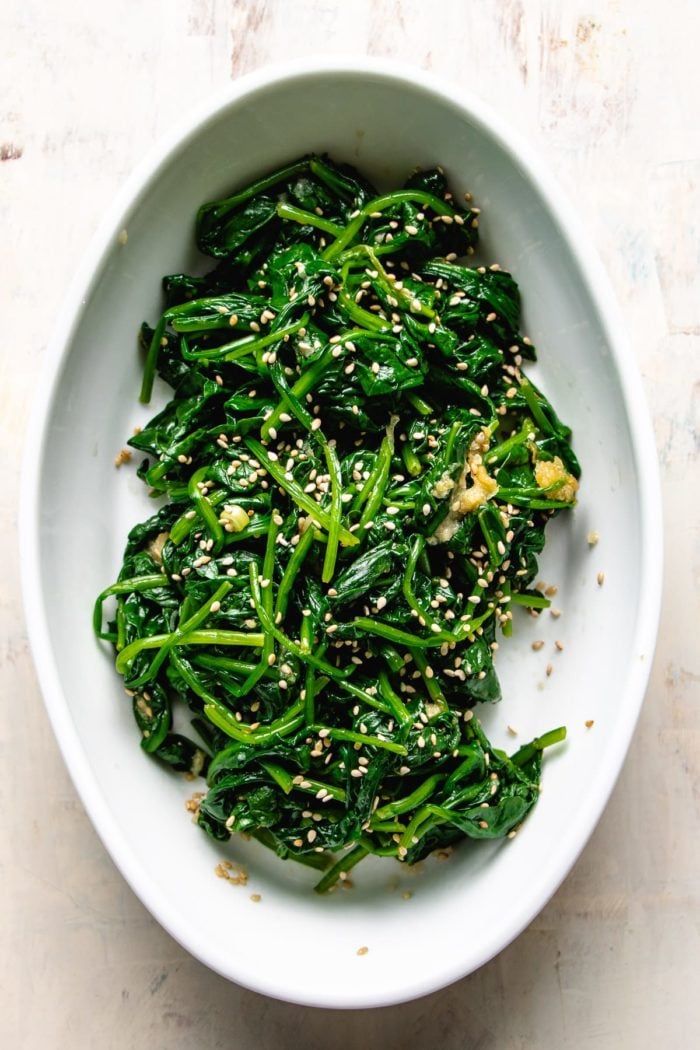
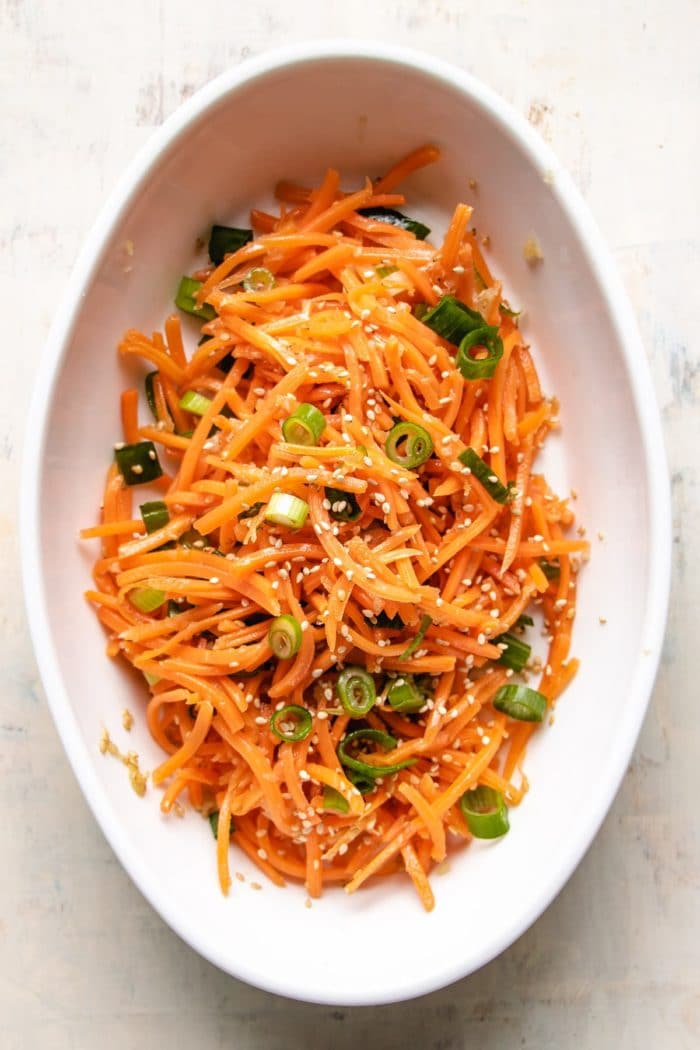
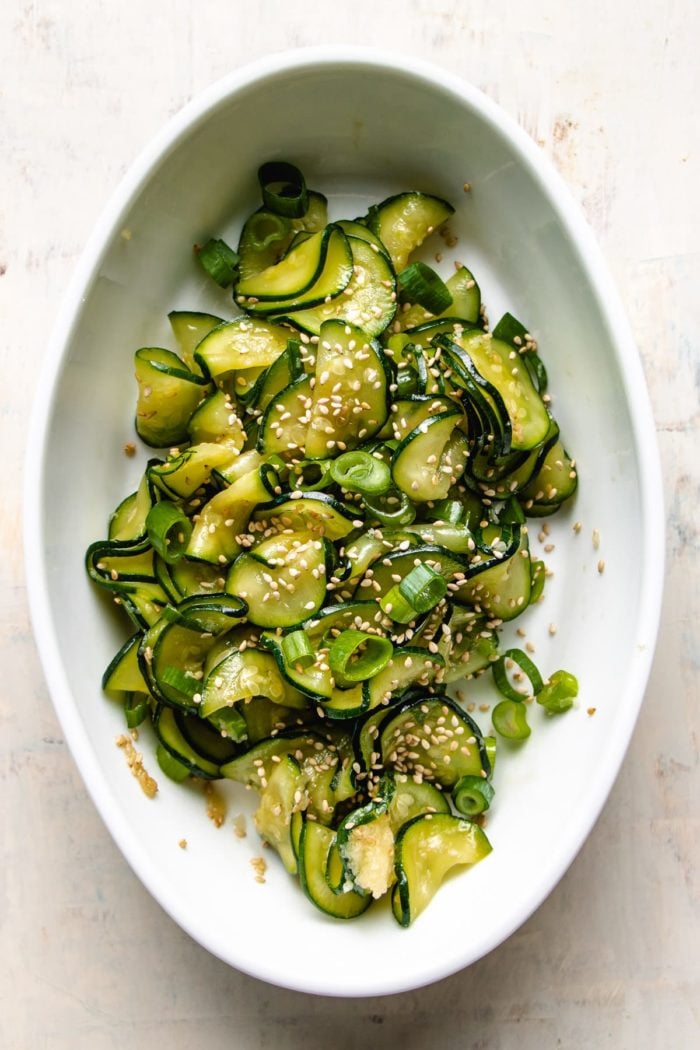
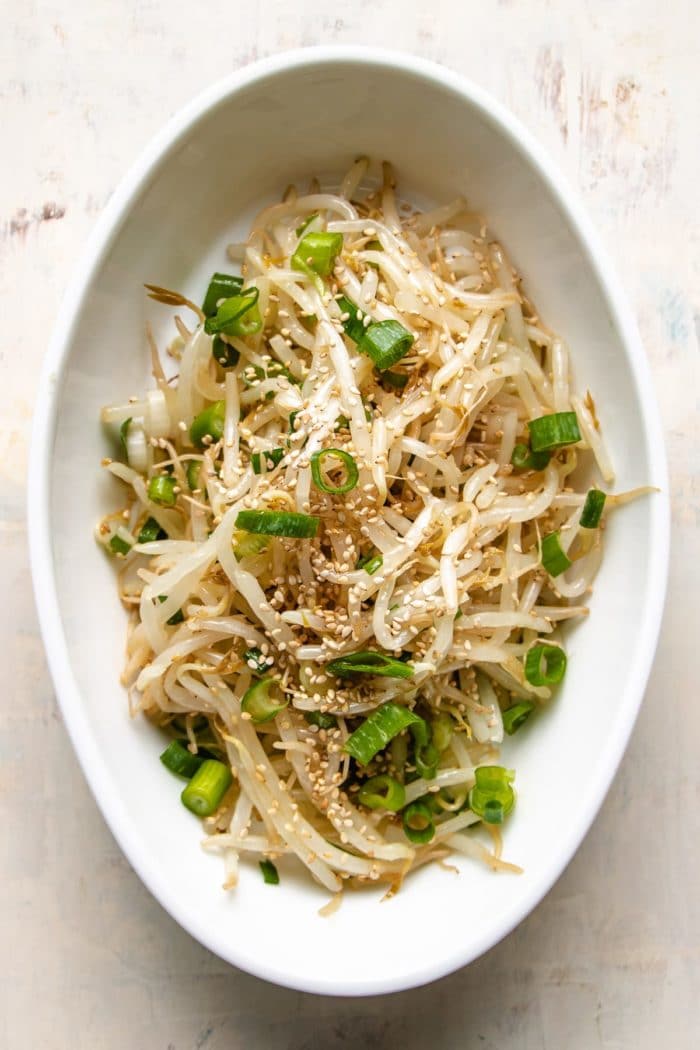
Endless Bibimbap Toppings and Swap Suggestions
Besides mung bean sprouts, carrots, zucchini, spinach, you can also saute fresh shiitake with some salt, toasted sesame oil, and a dash of coconut aminos to add extra umami. My Chinese broccoli in vegetarian oyster sauce is another fantastic topping, too! If you are not a vegetarian, add bulgogi beef, roasted salmon, or even smoked salmon like I did in the photos. 🙂
Also check out some of my vegetarian recipes – Whole30 vegetarian curry , Vegetarian Oyster Sauce, , 60+ Whole30 Vegetarian Vegan recipes , and gluten-free Korean recipes!
Friends! This vegetarian bibimbap korean-inspired recipe is a great make-ahead meal. Each veggie component is a side dish itself and it tastes EVEN BETTER when chilled! Top with a super crispy sunny side up fried egg and a few big spoonfuls of bibimbap sauce, mix it all up into one big bowl of delicious mess and ENJOY!

Vegetarian Bibimbap Recipe with bibimbap sauce
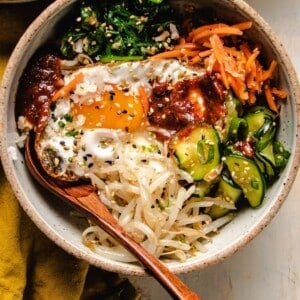
Ingredients
- 3 medium zucchinis
- 3 medium carrots
- 10 oz. mung bean sprouts
- 10-15 oz. spinach
- ½ tsp fine sea salt for each vegetable item or to taste
- 1.5- 2 tsp grated garlic for each vegetable item or to taste
- 2-3 tsp Toasted sesame oil for each vegetable item or to taste
- 3-4 bulbs scallions chopped, about 1 bulb for each vegetable item
- Toasted white sesame seeds sprinkle
- 1 tbsp coconut aminos for each vegetable item or to taste, optional
Bibimbap Sauce:
- 6 whole medjool dates torn apart with your hands
- 3 tbsp water
- 2.5 tbsp apple cider vinegar
- 2-3 tsp gochugaru or 1 tsp cayenne pepper
- 2.5 tbsp tomato paste
- 2 tbsp coconut aminos
- ½ tsp garlic powder
- ½ tsp onion powder
- Little salt to taste
- 1 tsp toasted sesame oil
- 1 tsp apple cider vinegar or rice vinegar, to taste
Other:
- 1-1.5 tbsp avocado oil to saute zucchini
- 4 large eggs pan fried sunny side up
- Cauliflower fried rice or steamed white rice
Instructions
For the zucchini, if using:
- Slice the zucchini to a little thinner than ¼-inch (0.6 cm) in thickness or use a mandolin slicer. Sprinkle 1.5 tsp fine sea salt and gently rub the salt into each slice. Let sit at room temperature for at least 20 minutes or up to 1 hour. Squeeze out the water then do a quick saute with avocado oil, garlic, and sesame oil. Sprinkle scallions and sesame seeds. Chill in the fridge.
For the carrots, mung bean sprouts, and spinach:
- Julienne the carrots. These vegetables have the same cooking steps but please cook them separately. Bring a large pot of water to boil and season with some salt. Hot water blanches the carrots for 2 minutes, bean sprouts for 2 minutes, and spinach for 30 seconds. Soak in cold water and squeeze out the liquid. In a big mixing bowl, season each vegetable item with salt, garlic, sesame oil, scallions, and sesame seeds. Taste and adjust the salt quantity. Chill in the fridge. I like to add a tablespoon of coconut aminos for extra flavor but that’s totally optional.
For the bibimbap sauce:
- In a small food processor, add the ingredients from the dates to salt. Blend a few times until you get a smooth paste. You might need to scrape the bowl a few times. Transfer the paste to a small bowl. Stir-in the sesame oil and vinegar. Adjust the vinegar quantity to taste.
To assemble:
- Add the cooked rice (or cauliflower rice) to the bottom of serving bowls, place each vegetable item on top of the rice. I like to alternate the colors between the vegetables so they look colorful. Top with a sunny side up fried egg, a big spoonful of homemade bibimbap sauce, and a teaspoon sesame seeds. Mix it all up with a spoon and dig-in!
Notes
- If you are not a vegetarian, try adding bulgogi beef, roasted salmon, or even smoked salmon like I did in the photos.
- Besides bean sprouts, carrots, zucchini, and spinach, you can also saute fresh sliced shiitake with some salt, toasted sesame oil, and a dash of coconut aminos as another topping choice.
- This is a great make-ahead summer recipe as each vegetable item can be served independently. Check out my Korean-inspired mung bean sprouts recipe and chilled zucchini side dish.
- Store the vegetables in a sealed container and in the fridge. Best finish in 4-5 days. Zucchini and bean sprouts will continue to produce more liquid as they sit in the fridge but that won’t affect the flavor.
Nutrition
Nutrition information is automatically calculated, so should only be used as an approximation.
WHAT TYPE OF RICE IS USED IN BIBIMBAP
Short grain white rice or sushi rice is often used in Korean bibimbap dish. The rice is steamed and has a soft and fluffy texture yet little starchy and chewy.
HOW TO EAT BIBIMBAP
Bibimbap is often served in large rice bowls with vegetables on top of the rice and the gochujang bibimbap sauce on the side. To eat, add the sauce to the bowl and use a spoon to mix everything up.
WHAT IS BIBIMBAP BOWL
Bibimbap is a Korean rice bowl dish features steamed white rice with various chilled vegetables. It is served with bibimbap sauce (Korean chili paste). The toppings are varied. Bulgogi beef is a popular ingredient for bibimbap bowls.
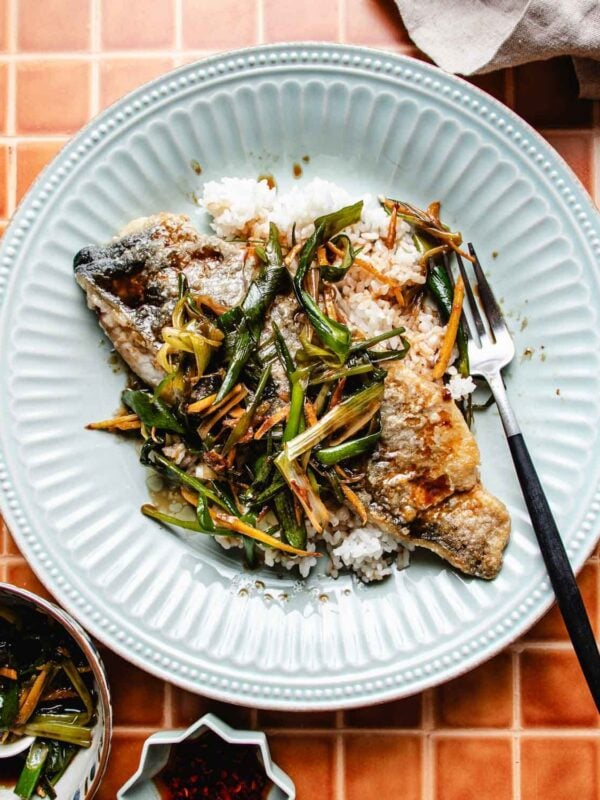

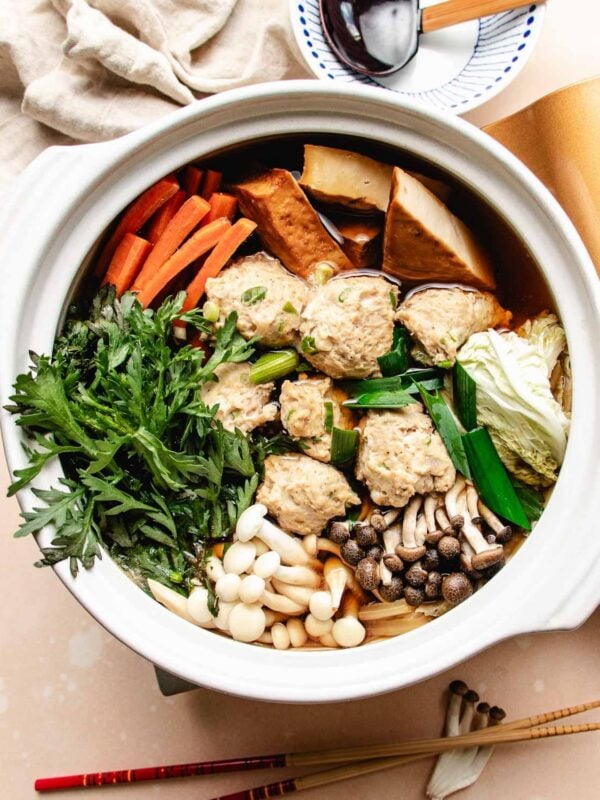
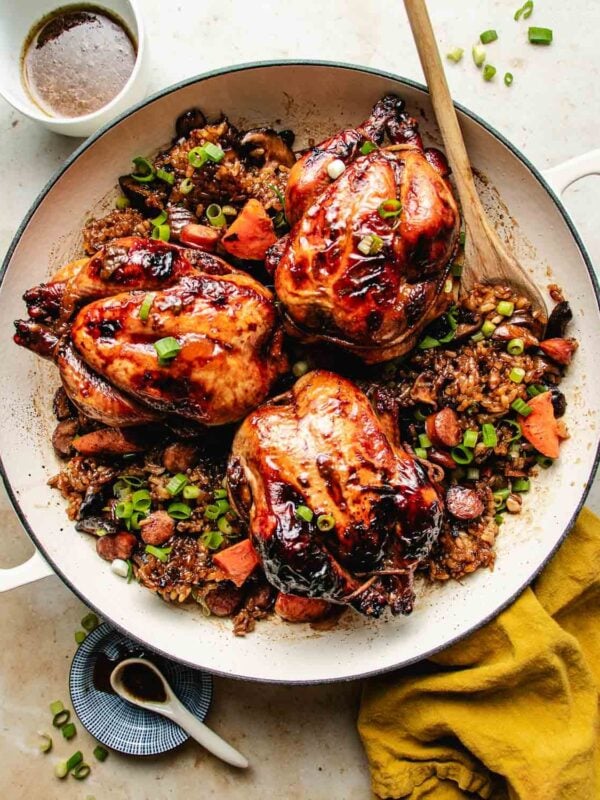









Fantastic sauce. We used dried apricots with a splash of maple syrup, and tamari, as we did not have dates or coconut aminos on hand. A keeper! Thank
Thank you. So happy to hear!
Any difference between using soy sauce or tamari instead of coconut aminos?
Yes. Coconut aminos is sweeter and less saltier than soy sauce. Soy sauce tastes more astringent. You’ll use less amount and need to add a bit sugar to balance the flavor.
This was really good! The whole family loved it! The Bibimbap sauce was delicious! We served it on Yakisoba noodles w/cabbage, and it was super yummy that way! (We just had different rice bowls the night before, so we wanted noodles…but this would be so good with rice, too!) We also threw in some “Plantspired” brand Korean BBQ flavored vegan steak tenders that we found at the grocery store & it was amazing! But it would’ve been really good even without that! I’ll definitely make this again!
Wonderful! So happy to hear, Thanks for sharing.
How long will the bibimbap sauce keep in the fridge? I was thinking of making a batch ahead of time for convenience. Thank you, recipe looks great! 🙂
No problem. I think 3 weeks should be fine? Please use a clean spoon whenever you dip into the jar. I recommend using a glass jar with a tight lid. 🙂
Thank you! I look forward to trying this! 🙂
Can I replace the dates with monkfruit sweetener? I’m on a anti candida diet so need to limit my sugar.
Yes! Adjust it to taste.
I’m really froud of you madom.
I 💕 u and your recipe.
Thank you!
Your recipes are absolutely amazing! Everything I’ve made so far came out exactly as promised. I appreciate that you keep ingredients to a minimum, offer alternatives for harder to get ingredients – and above all make Asian dishes available for those of us aiming for a low carb or Paleo diet. Your Instagram posts are so inspiring! Thank you for posting and sharing your expertise. Warmly, Tanja
Thank you so much!